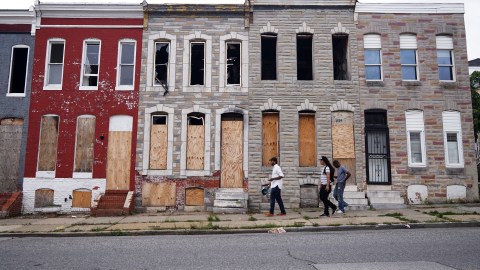Study finds that landlords exploit the poor

Photo credit: MANDEL NGAN / AFP / Getty Images
- A new study examined the profits of landlords across Milwaukee and compared them to landlord profits nationwide.
- They found that for every 10 percent increase in neighborhood poverty, renter exploitation increased by 2.2 percent in Milwaukee and 0.8 percent nationwide. What’s more, for every 10 percent increase in black residents, renter exploitation increased by 0.8 percent for both Milwaukee and the nation.
- This effect ensures that the poor remain poor; since the poor have no choice but to pay rent when they can, any money they could save up is instead siphoned away by landlords.
Anybody who’s ever been in poverty before can tell you: It’s expensive to be poor. Wealthy people can afford to buy high-quality, long-lasting products or to buy other products in bulk. Not true for the poor. With few resources to spare, the impoverished have to buy crappy cars that constantly need repairs and work physically demanding, minimum-wage jobs that can result in expensive healthcare costs. If you’re poor and need a loan, the only one you’re going to get will come with a high interest rate attached, reflecting the lender’s concerns that you won’t pay it back.
Now, new research in the American Journal of Sociology demonstrates how rent is another method by which the poor are kept poor. Surprisingly, the researchers found that the best way for a landlord to make money is not to buy a house in an affluent neighborhood and rent it out. Instead, the most money is to be found by exploiting the slums.
Exploitation can be defined as one group excluding another from a useful resource, enriching itself in the process. In this case, that resource is housing. The researchers quantified this concept as “exploitation rates,” or what percentage of a property’s value renters paid each month.
In low poverty neighborhoods, defined as those where the poverty rate was less than 15 percent, renters faced an exploitation rate of 10 percent. So, each month, a renter paid one-tenth of the property’s value. In high poverty neighborhoods, where the poverty rate was between 50 and 60 percent, renters paid a full quarter of their property’s worth in rent each month.
What’s more, black neighborhoods faced about double the exploitation rate of nonblack neighborhoods: 10–15 percent versus 20–25 percent, respectively.

Photo credit: Drew Angerer / Getty Images
Using data to identify the exploitation of the poor
To discover this, the researchers examined a variety of datasets on the housing market. Specifically, they used detailed datasets focused on the Milwaukee housing market, which provided data on monthly rent; property values; expenses such as mortgage payments, property insurance, and regular maintenance costs; and uncommon, costly expenses like plumbing repairs.
Using this data, the researchers were able to create a model of exploitation that they could compare to a less detailed nationwide dataset, which confirmed that the nature of exploitation in Milwaukee was true across the U.S. In Milwaukee, renter exploitation increased by 2.2 percent for every 10 percent increase in neighborhood poverty. Nationwide, every 10 percent increase in local poverty increased exploitation by 0.8 percent. The similarity between Milwaukee and the rest of the nation was even more clear when looking at black versus nonblack neighborhoods: In both datasets, every 10 percent increase in the number of black residents increased exploitation by 0.8 percent.
Why slums make money
Landlords place higher rent on properties located in slums because they come with higher risk. The less valuable buildings are likely to be in worse condition, and landlords are concerned about nonpayment from the poor. But these concerns are exaggerated. The researchers did find that repairs were more common in properties located in slums and rent was more frequently missed, but the profits of landlords were still significantly higher. Specifically, landlords in Milwaukee made an average profit of $151 per month from a single unit in a poor neighborhood compared to $21 per unit in more affluent neighborhoods.
Part of this is because buildings with lower property values can easily be bought outright, which cuts out the cost of mortgage payments. Coupled with the fact that landlords frequently own multiple properties, being a slumlord can quickly become extremely lucrative:
Because landlords operating in poor communities cannot know with certainty whether a new tenant will cost them money, they may attempt to mitigate that risk by raising the rents of all their tenants, carrying the weight of social structure into price. Poor renters pay double — purchasing the good and the risk — but because losses remain infrequent in absolute terms, landlords typically realize the surplus “risk charge” as higher profits.
The researchers write that “landlords who have invested in a nonpoor neighborhood are not betting on today but on tomorrow. In poor neighborhoods, however, landlords are betting on today.” Properties in more affluent neighborhoods are more likely to gain value over the years compared to those in poor neighborhoods. So, landlords hope that the lower profit from affluent neighborhoods will be offset by the increased value of the property over time. But even when the researchers accounted for this, landlords in poor neighborhoods still came out ahead.
This presents the poor with the choice between homelessness or exploitation. Allowing that exploitation to happen eats away at any savings the poor might be able to accrue, guaranteeing that they’ll be confronted with that choice again. As the researchers put it, “money made slums because slums make money.”





